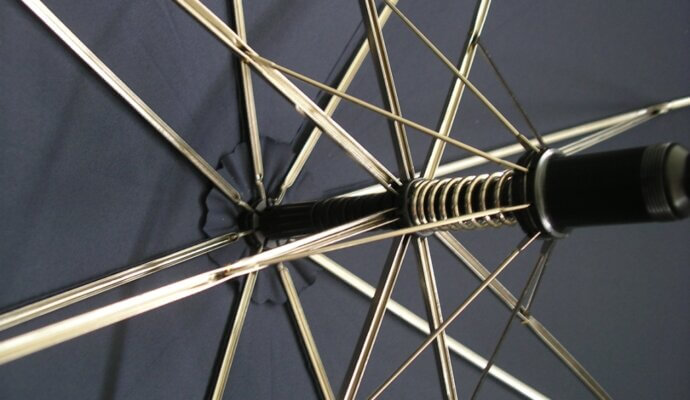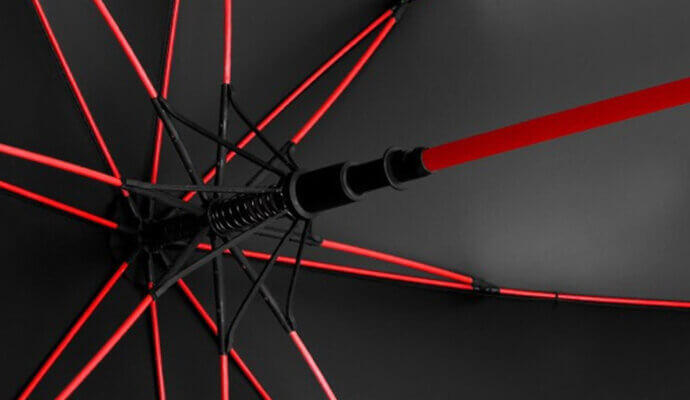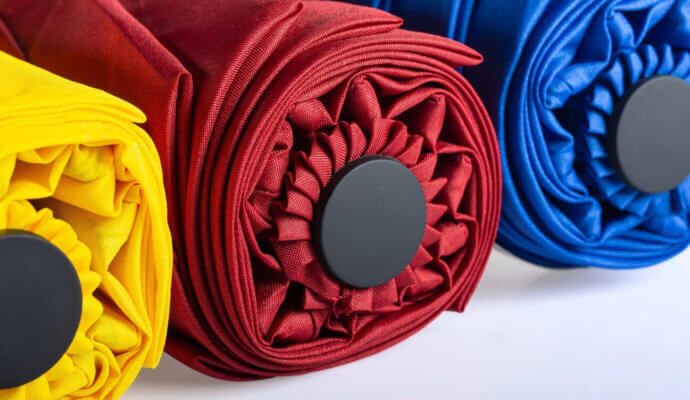Umbrellas are more than just accessories to shield us from the rain. They are a quintessential part of our daily lives, offering protection from the elements while adding a touch of style. However, beneath their canopy lies a crucial component: the frame. The frame material plays a significant role in determining an umbrella’s durability, flexibility, and overall performance. In this blog post, we will explore two common stick umbrella frame materials: metal ribs and fiberglass ribs, to help you make an informed choice the next time you are in the market for a new umbrella. And help the customer who wants to offer an umbrella project for their business.

Metal Ribs:
Metal ribs, typically constructed from materials like steel or aluminum, have long been the traditional choice for umbrella frames.
Here’s why:
-
Strength and Durability
Metal ribs offer excellent strength and durability, making them ideal for withstanding strong winds and harsh weather conditions. Steel ribs, in particular, are known for their robustness and ability to maintain their shape over time.
-
Stability
Umbrellas with metal ribs tend to be more stable, providing reliable protection even in windy conditions. The rigid structure of metal ribs helps prevent the canopy from collapsing or flipping inside out during gusts of wind.
-
Classic Aesthetic
Metal umbrellas exude timeless charm and elegance, making them a popular choice for both formal and casual settings. The sleek profile of metal ribs adds a touch of sophistication to any umbrella design.
However, despite their many advantages, metal ribs do have some drawbacks:
-
Weight
Metal umbrella frames can be heavier when compared to their fiberglass counterparts, which may become cumbersome to carry for extended periods, especially if you’re on the go.
-
Susceptibility to Corrosion
Steel and aluminum are prone to corrosion when exposed to moisture and humidity, leading to rust formation over time. Regular maintenance and proper care are essential to prolong the lifespan of metal umbrella frames.

Fiberglass Ribs:
Fiberglass has emerged as a popular alternative to metal for umbrella frames, offering a unique set of benefits:
-
Lightweight
Fiberglass is significantly lighter than metal, making umbrellas with fiberglass ribs more convenient to carry and use, particularly for extended periods.
-
Flexibility
Fiberglass has a natural flexibility that allows the umbrella to bend and flex without breaking. This flexibility helps prevent damage to the frame during strong winds, reducing the risk of breakage or deformation.
-
Resistance to Corrosion
Unlike metal, fiberglass is not susceptible to rust or corrosion, making it an excellent choice for umbrellas that will be frequently exposed to moisture.
However, fiberglass ribs also have their limitations:
-
Durability
While fiberglass is resilient and flexible, it may not be as durable as metal in certain situations. Fiberglass ribs are more prone to snapping or breaking under extreme pressure, such as heavy winds or impact.
-
Cost
Umbrellas with fiberglass ribs tend to be slightly more expensive than those with metal ribs due to the higher cost of materials and manufacturing processes.
Measurement of stick umbrella long ribs
For stick umbrellas, there are two kinds of frames of long ribs. One is metal “ U “shape ribs or metal round ribs, and the other one is fiberglass ribs. Both metal ribs and fiberglass are widely used for umbrella sizes between 17-inch to 25-inch straight umbrellas.
For umbrella sizes above 25-inch straight umbrellas(golf umbrellas), almost all long ribs of the frame are fiberglass, except for double “U” shape long ribs.
Regarding the metal ” U “ shape ribs, rib sizes(i.e.the thickness of the metal rib) regularly have 5.8φ,6.0φ,6.3φ, and 7.0φ.
Regarding the metal round shape ribs, ribs size regularly have 1.7φ, 1.8φ, and 2.0φ.
Regarding the fiberglass ribs, rib sizes (the diameter of the long rib) regularly have 2.8φ, 3.0φ, 3.5φ, 4.0φ, 4.5φ, and 5.0φ.
We can use the vernier caliper to measure the rib size. Different frames match different kinds of ribs. For special requests, ribs also can be changed.
Conclusion:
When choosing between metal ribs and fiberglass ribs for your umbrella frame, it’s essential to consider your specific needs and preferences. If durability and stability are paramount, a metal rib umbrella may be the best choice, providing reliable protection in adverse weather conditions. On the other hand, if lightweight construction and flexibility are more important to you, a fiberglass rib umbrella may be the way to go, offering easy portability and resilience in moderate weather.
Ultimately, both metal and fiberglass rib umbrellas have their own unique strengths and weaknesses, and the right choice depends on factors such as intended use, climate, and personal preference. By understanding the characteristics of each material, you can make an informed decision and select the umbrella frame that best suits your needs.


